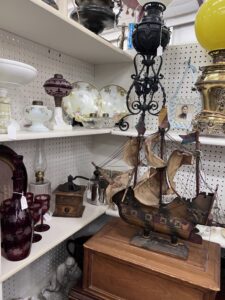What’s Old is IN
Make a Statement with Antique and Vintage Decor
You may not be familiar with the word “anemoia,” but if you’ve ever looked longingly at things or wistfully wondered about times of a past long gone, you’ve certainly experienced it.
A “new and nearly unheard-of word, its meaning… is a nostalgic sense of longing for a past you yourself have never lived.”*

Of course, there’s also the nature of recognizing sentimentality for what you have come to know, personal memories of your history brought on by an item or idea that evoke feelings of happiness and simplicity.
Antique versus Vintage
Art, furniture, glassware and both functional and decorative items of yesteryear fall into two categories: antique and vintage. Area experts say the terms are not interchangeable, and there’s a true difference between the two.
“An item technically needs to be 100 years old to fall into the antique category,” Katie Bourassa, Auctioneer and Owner of Memories Antique Mall in Little Chute, says. “For a lot of people that’s hard to wrap their head around. It’s like telling someone in their 40s that the 1990s were 30 years ago—it feels like it was more like 10—and it makes you really start to feel your age. Items from the 1920s are now considered antique… from the 20th century!

” Items between 30 and 70 years old are considered vintage. After that point production values and means changed altogether.
“In about 1990, styles started to trend away from traditional styling that was discernible by where it was made and by the types of craftsman,” John Melchert, Marketing Manager of Harp Gallery in Kaukauna, explains. “Thirty years ago things became much more homogenous and modern, and we switched to factory furniture production.”
It’s precisely that shift—and the outstanding quality and thoughtful design of antique and vintage pieces—that has played a big part in the increased interest in the hunt for such items to decorate homes.
“I’ve heard it said that you need to ‘buy it nice, or buy it twice,’” Bourassa says. “If you are going to purchase something for your home it should be a quality item, so that you don’t need to purchase a replacement any time soon, if ever. Antiques were meant to be used, they were meant to be loved, they were meant to stand the test of time.
“Oftentimes, there is hand carving on furniture, hand painting on dishes and after-market personalization on linens, jewelry and more. Having those unique accents is not only going to add character to your home but it will give you conversation starters that can spur some of the most delightful memories. It is more likely that you will have a one-of-a-kind piece if you purchase it secondhand than if you purchase it at a big-box store.”
“I enjoy things that are smaller in scale and have design features and attributes you don’t see in contemporary furniture,” Gregory Reinhardt, Co-owner of Mid-Century Madness in Menasha, agrees. “You see a lot of mimicry going on, some mid-century influenced design that’s affordable, but the quality isn’t there.”

The restoration of such antique furniture is a precise and delicate art that demands a careful, and knowledgeable, touch. The Harp Gallery specializes in this refurbishment.
“We have a team of about 30 restoration guys and gals who work in the back of the building who all have a specialty that ranges from carpentry to electrical work, to touching up paintings and upholstery, working on metal, all sorts of stuff,” Melchert says. “Some of it may have taken a year of a woodworker’s life to build. Think about the tools they had to use! It’s interesting working on it because we have a state-of-the-art workshop, but there are certain elements to this process that you can’t replace and update to become modern. It’s really a combination of age-old tools and techniques with whatever sort of modern twists you can put on it to save time and energy.”
The same goes, on a smaller scale, for vintage finds.
“Everything (at Mid-Century Madness) gets TLC,” Reinhardt says. “Virtually everything will get, at minimum, cleaned. Most pieces will be re-oiled. We touch everything in one way, shape or form. Our intent is to get it to a condition where we would bring it into our house. That’s our rule of thumb. Would I take this home? If not, it’s not going to hit the showroom floor.”
Why and How to Decorate with Pieces from the Past
“These items may already be in your family and they might carry sentimental value,” Melchert says. “If your grandmother loved (something) and it served her well her whole life, there’s memories made around it, it’s an irreplaceable thing. In terms of why you might buy antique furniture, I think quality is where it is. These things are sturdy, outstanding. They will be ready to serve you—even if you beat them up and they need repairs—they’ll be ready to serve you if you put time and energy into them again.”

“Part of it is keeping things out of the landfill, being environmentally conscious,” Reinhardt adds.
Mid-century, from roughly 1945 to 1969, introduced a whole new style of “modern,” and depending on the decade, varied in color trends. The ‘50s was predominantly neutral tones: beige, browns, grays and sort of a pinky gray. The ‘60s began seeing the use of greens, oranges, browns and golds, and the ‘70s introduced more “wild” colors like pink and blue.
“I think people should gravitate to it—especially people who have bought houses in the period. The scale of the furniture makes the house look larger. It creates a more functional space. We’re looking for things that have clean, straight lines. No turned legs, no neural details, nothing provincial. Nothing colonial,” Reinhardt explains. “We’ll even shy away from the Hollywood regency period of the mid-century just because it is almost gaudy… things with natural wood, tapered legs.
“The designs and styles are just typically iconic. They’ve stood the test of time. The fact that they’re still here is a testament to that. The fact that there’s still such a demand for it 50, 60 years later should make you want to gravitate to run in that small circle versus the commercialized, contemporary furniture of today.”
Much of furniture and interior design was influenced heavily by world events. “It’s fun from a historical perspective to see how much furniture design and interior design of the day was following that which was in the news,” Reinhardt says. “You gotta remember, this was back in the time when there were two or three broadcast channels, LIFE Magazine was huge. Everyone read the newspaper. Your news came from that.
“You had these little subsets of design influences that were readily seen in the interior design world that you don’t see today. It’s a splash of color but it’s not thematic,” Reinhardt says. “It was a reflection of what was going on, and unless you lived in the time, you don’t make that association.”
When considering decorating your space with antique and vintage finds, the rules vary—if one can consider there being guidelines at all.
“The only rule that is truly evergreen is that you should decorate your home with whatever makes you happiest. Make your home some place that you are proud of. Have the furniture squishy and comfortable. The artwork done by friends or something you found hidden in the back of a closet at an estate sale,” Bourassa explains. “Display your collections proudly and loudly on shelves and walls. Bringing together all your favorite things into one space will give a cohesive feel regardless of whatever trends are circulating on TV or in magazines.”

“If you haven’t taken a look, go grab yourself a copy of Atomic Ranch Magazine,” Reinhardt urges. “That would be a suggestion for anyone wanting to get into it. Use it as an idea factory. They feature a couple of houses that are dedicated to this. But a list of advertisers will also get you into all of the sundry items to finish that design look: people who are making retro doors and mailboxes, light fixtures. Not everyone can find or has the time to go thrifting or shopping for a 1974 frosted glass globe light. It’s a good place to start.”
“I personally keep a little bit of both in my house,” Melchert says. “It’s hard to keep only antique and vintage furniture; sometimes you just want something comfortable and modern. But there’s nothing that replaces a statement piece.”
“Half of the fun of doing this is the stories you get to hear,” Reinhardt reflects. “You get to rehome items that were loved through their entire life. Now you get to rehome them for people who are going to love them even longer.”
“Buy it when you see it!” Bourassa adds. “I can’t tell you how many hearts I have broken when people come back for something they saw the week prior, and it’s already gone… you’ve got to get it while the gettin’ is good!”
*www.jwbarlament.medium.com










Leave a Comment